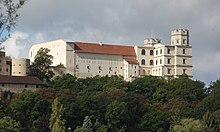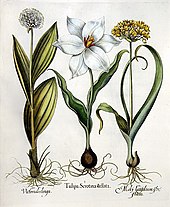Hortus Eystettensis
The Hortus Eystettensis ("Eichstätter Garden") was a botanical garden that was laid out on the bastions of Willibaldsburg in Eichstätt during the Renaissance under Prince-Bishop Johann Konrad von Gemmingen .
The plants in the garden were described in the magnificent botanical work Hortus Eystettensis , which was first published in 1613 on behalf of the Prince-Bishop.
The " Eichstätter Bastion Garden ", which was re-established in 1998 at Willibaldsburg, is sometimes referred to as Hortus Eystettensis , but it only shows the plants that were described in the work.
history
Even before Prince-Bishop Johann Konrad von Gemmingen had the famous Hortus Eystettensis laid out, there were gardens at Willibaldsburg. Prince-Bishop Martin von Schaumberg (1523–1590) had "newe gardens [...] behind the castle" laid out.
Archbishop Gemmingen, who was in office from 1595, commissioned the doctor and botanist Joachim Camerarius (1534–1598) to expand the garden, which was implemented from 1597. After his death, the Nuremberg pharmacist Basilius Besler (1561–1629) continued his work. The "Hortus Eystettensis" consisted of eight garden areas around the residence on the Willibaldsberg; the gazebos of the Prince Bishop came on a "botanical Stairs" (staircase with plants painted wooden coffered ceiling).
The prince-bishop's love of nature was probably not the only decisive factor in laying out the garden; the complex with the precious and exotic plants was also a representation of his princely power.
The commissioning of the graphics, which represented the plants shown there, was the logical continuation of this presentation of power.
In 1613 the magnificent work “Hortus Eystettensis” was published, written by the pharmacist , botanist, collector, engraver and publisher Basilius Besler from Nuremberg (1561–1629). The printing was probably done in different workshops. The work shows plant species from all over the world, including 349 species that were found in Germany, 209 of southern and south-eastern European origin, 63 Asian, 9 African and 23 American species. It remains to be seen whether these plants all grew in the prince-bishop's garden on Willibaldsburg . The book is an important contribution to the prince-bishop's, cosmopolitan representation beyond the small principality.
After the Prince-Bishop's death in 1612, the garden was neglected. Parts of the garden were lost in favor of extensions to the bastion.
The garden was damaged in the Thirty Years War (1618–1648). Restoration began in 1648 under Prince-Bishop Marquard II. Schenk von Castell (1605–1685), and the garden was intact for the last time under Prince-Bishop Johann Anton I. Knebel von Katzenelnbogen (1646–1725). After that there was only a kitchen garden.
The gardeners lived outside the castle. From 1710/12 the so-called Botanikerhaus below the castle on Mondscheinweg was preserved as a residential stable house, the renovation of which was completed by the Bavarian State in 2007. A fountain bowl from the 17th century has been preserved from the stone garden decorations of the prince-bishop's garden.
The newly built in 1995 by the Bavarian Palace Department in the northern bastion of the outer bailey, the "forging Bastion" and in 1998 opened " Bastion Garden " testifies to the former glory of the Prince Bishops representation garden. It is unclear where the historic garden was actually located.
See also
literature
- Basilius Besler : Hortus Eystettensis. 1613.
- Bruno Boegl: A “little narrow garden” Johann Konrad von Gemmingen's “Hortus Eystettensis” . Munich / Murnau 1958.
- The Eichstätt garden the large herbarium of Basilius Besler from 1613. Munich 1988. (Reprint from a hand-colored copy of the first edition of the Bibliothèque Nationale de Paris)
- Hortus Eystettensis the Bishop's garden and Besler's magnificent book . Abrams, New York 1995.
- Hortus Eystettensis. A forgotten garden? Exhibition booklet. Eichstatt 1998.
- Monika Schattenhofer: “In my little narrow garden” of the Hortus Eystettensis by Johann Conrad von Gemmingen . Munich 1998.
- Karl Röttel (editor): Contributions to the last court architect and the new "Hortus Eystettensis" . Association of Friends of the Willibald Gymnasium, Eichstätt 1999.
- Daniel Burger : The view of the Hortus Eystettensis. The "Large Altane" on the Willibaldsburg as the art chamber of Eichstätter Bishop Johann Conrad von Gemmingen. In: Research on castles and palaces 5. Munich / Berlin 2000, pp. 187–198.
- Werner Dressendörfer: Hortus Eystettensis. In: flowers, herbs and essences. Darmstadt 2003, p. 42f.
- Werner Dressendörfer: The plants of the Hortus Eystettensis. A botanical and cultural-historical walk through the garden year . 2006.
Web links
Individual evidence
- ↑ https://www.eichstaett.de/sehenswerte/bastionsgarten_mit_ Pflanzen_au-1756 /
- ↑ History panel of the town of Eichstätt , eichstaett.de; Accessed September 28, 2019
- ↑ Sabine Schulze (Ed.): Gardens: Order - Inspiration - Happiness. Städel Museum , Frankfurt am Main / Hatje Cantz Verlag, Ostfildern 2006, ISBN 3-7757-1870-2 , p. 42.

